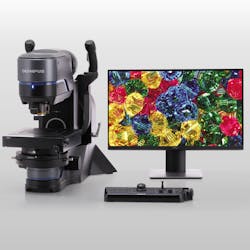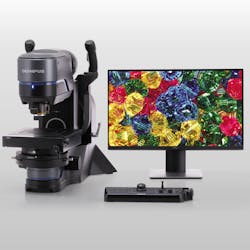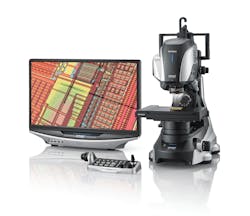Microscope makers offer faster, precise products
Microscope makers are launching advanced devices that provide greater magnification, improved precision and faster inspection of plastic parts and mold components.
OLYMPUS LAUNCHES DSX1000
Plastics processors can benefit from the faster inspections and analyses of the new Olympus DSX1000 digital microscope, according to Olympus, a 100-year-old optics company based in Japan.
The new model launched worldwide June 1.
The DSX1000 is available with 17 lenses that are part of a quick-lens-change system that allows operators to switch lenses in a matter of seconds as compared to several minutes. The lenses have different characteristics and pricing. The digital microscope also has a 10-times optical zoom. For example, one lens can provide magnification from 20 times to 200 times, while the next lens can provide magnification of 200 times to 2,000 times, and so on, said Doug Kennedy, national sales manager for advanced microscopy at Olympus America Inc., Scientific Solutions Group. Only three lenses are required to cover the full magnification range.
The lens-change system differs from its competitors, Olympus said.
“It’s a completely different design so the lenses simply slide in and slide out of the microscope,” Kennedy said.
Other systems use wires, cables and lights that need to be detached before a lens is disconnected and changed. Once the new lens is installed, those traditional models require the operator to reconnect the wires, cable and lights, he said.
Examining plastic parts for defects at high levels of magnification can be difficult because of a lack of contrast, especially on solid-colored parts. The DSX1000 offers six different techniques or observation methods to help operators see minute features.
“These techniques — brightfield, darkfield, polarized light, Nomarski DIC [differential interference contrast], oblique and mix mode — all exist so that when you look at the sample at high magnification, you can actually see detail,” Kennedy said. “Our system is unique in that it has all those techniques available from the lowest magnification to the highest magnification. This is important because it allows you to see your features. If you can’t see your features, there is no point in looking at it at high magnification.”
The DSX1000 uses a telecentric optical system that measures precisely, accurately and repeatably, according to Olympus.
To ensure accuracy, an Olympus technician can calibrate each microscope after it has been installed in the customer’s facility.
“Another key aspect of our system is we can perform a NIST-traceable [National Institute of Standards and Technology] calibration of the microscope on-site for customers so we can guarantee the accuracy and repeatability of our system,” Kennedy said. The NIST-traceable calibration is an optional service.
Various sectors of the plastics industry, ranging from makers of low-cost nozzles for aerosol spray cans to manufacturers of precision medical devices, use microscopes in developing prototypes and checking the quality of finished products.
For example, makers of shampoo and lotion bottles might use a microscope to look at bottle cross sections to determine layer thicknesses and ensure that the different layers are adequate to protect the contents.
Manufacturers of spray-can nozzles might inspect a sampling of products as they come off the line to look for defects such as flash or an incomplete filling of a mold that prevents the nozzle from being formed properly.
At the other end of the spectrum, medical device manufacturers want to ensure that parts have a specific fit and finish, as well as precise dimensions.
“Our newer, faster digital microscope can meet these plastics industry needs faster and more accurately than with other microscope products,” Kennedy said.
MAHR'S MARSURF CM LINE BOASTS HIGH PRECISION
Mahr’s new MarSurf CM series optical 3-D confocal microscopes are targeted at industrial and research applications.
MarSurf CM’s confocal microscopes with high-precision, 16-bit high-dynamic-range technology deliver high-resolution 3-D surface topography data, enabling new insights into surface structures and processing, according to the company.
Plastics processors can use it to measure the height of flash on a plastic part or check mold alignments, Pat Nugent, VP of product management at Mahr, said.
The MarSurf CM series also allows users to measure a surface finish or texture to ensure it meets specifications, whether those specifications are for purely cosmetic reasons or essential to the performance of a part.
In manufacturing medical devices, like a hip implant, surface finish is critical. The ball in a hip implant needs to be smooth. But the shaft of that hip implant should be rough because it gets inserted into the bone and the rough texture is important for the regrowth of the bone to the implant, Nugent said.
The MarSurf CM technology acquires a true-height signal as opposed to measuring height via pixel contrast or pattern projection. Confocal technology can be used on any material, whether it scatters light or is highly reflective.
MarSurf CM systems provide nanometer resolution and information about a part’s surface finish, including roughness, flatness, depth, volume and more.
The measurement and data evaluation processes can be automated, the company said. For example, the systems can automatically detect and correct possible errors in sample positioning without user input, and they can automatically generate “go/no-go” reports that indicate whether a sample passed testing.
Mahr provides surface-finish and micro- geometry results according to ISO, EN and ASME standards for both 2-D and 3-D images.
The MarSurf CM microscopes are available in various models including:
• MarSurf CM explorer, a compact and user-friendly model suitable for economical use in laboratories and for quality assurance in production environments.
• MarSurf CM expert, which is optimized for use in testing and development laboratories.
• MarSurf CM select, which can be adapted by Mahr to suit customer-specific requirements. A large selection of hardware and software components is available. Thanks to its modular design, the measuring system can be adapted to different tasks and individual requirements for automation, measuring convenience and accuracy.
• MarSurf CM mobile, a portable model for measuring large objects and samples that are difficult to move, such as vehicle bodies. It weighs only 11 pounds.
KEYENCE INTRODUCES THE VHX-7000 SERIES
With a push of a button, high-definition (HD) capturing makes it possible to observe subtle contours and uneven surfaces or stains that were previously impossible to view, the company said.
Because the microscope has a fully integrated head, there is no need for lens replacement. An operator can simply turn a knob to adjust the magnification between 20 times and 6,000 times.
The VHX-7000’s depth of field is 20 times larger than conventional optical microscopes.
The microscope, which debuted in June, is fully automated with a motorized turret that is controlled from a single console that can adjust features, such as focus and magnification. An automated XYZ system allows multi-angle viewing.
“The VHX-7000 marks the fifth generation of our product line and is the greatest hardware advancement to date,” said Kevin Wilhelm, a corporate technical engineer for Keyence.
“With the VHX-7000, your images will be displayed in 4K Ultra HD, providing you with the most accurate images you have ever seen.”
The microscope also features adaptive lighting and focusing, and high-numerical aperture (NA) lenses (up to 0.9 NA) that resolve fine detail in an object being observed.
Bruce Geiselman, senior staff reporter
Contact:
Keyence Corp. of America,
Itasca, Ill., 888-539-3623, www.keyence.com/VHXPM
Mahr Inc.,
Providence, R.I., 401-784-3100, www.mahr.com
Olympus Scientific Solutions,
Waltham, Mass, 781-419-3900, www.olympus-ims.com/en/
About the Author
Bruce Geiselman
Senior Staff Reporter Bruce Geiselman covers extrusion, blow molding, additive manufacturing, automation and end markets including automotive and packaging. He also writes features, including In Other Words and Problem Solved, for Plastics Machinery & Manufacturing, Plastics Recycling and The Journal of Blow Molding. He has extensive experience in daily and magazine journalism.


